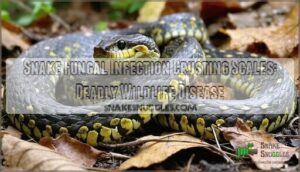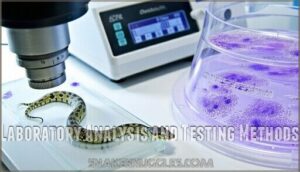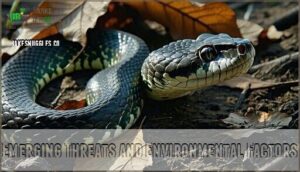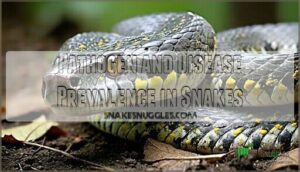This site is supported by our readers. We may earn a commission, at no cost to you, if you purchase through links.

This emerging wildlife illness causes yellowish, crusty patches that can make snakes look like they’re wearing a rough mask.
The fungus Ophidiomyces ophiodiicola attacks the skin, creating ulcers and abnormal bumps beneath the surface, it’s like nature’s version of a bad skin condition, but far more serious.
SFD can be fatal if left untreated, affecting wild populations across North America.
What makes this disease particularly tricky is how it mimics other conditions—and why quick identification matters for conservation efforts.
Table Of Contents
- Key Takeaways
- Snake Fungal Disease Overview
- Signs and Symptoms of SFD
- SFD Detection and Diagnosis
- Research and Management of SFD
- SFD in Wild Snake Populations
- Emerging Threats and Environmental Factors
- Pathogen and Disease Prevalence in Snakes
- Conservation Implications of SFD
- Current Research and Findings
- Reporting and Responding to SFD Cases
- Frequently Asked Questions (FAQs)
- What does snake fungal disease look like?
- Why does my snake have scabs?
- What does a skin infection look like on a snake?
- How does snake fungal infection spread between snakes?
- What environmental conditions favor the growth of the fungus?
- Can snake fungal disease be transmitted to humans or pets?
- Are there any successful treatments for infected snakes in the wild?
- Can pet snakes contract SFD from wild populations?
- How long does SFD treatment typically take?
- Is SFD contagious between captive snake species?
- Conclusion
Key Takeaways
- You’ll recognize SFD by crusty, yellowish scales around the eyes, snout, and chin – these thickened patches often look like a rough mask and can progress to open ulcers and bumps beneath the skin.
- Report suspected cases to wildlife authorities immediately – quick identification and reporting helps scientists track this emerging disease that’s spreading across 38 states and threatening snake populations.
- The fungus Ophidiomyces ophiodiicola can be fatal if untreated – it attacks snake skin, causes feeding difficulties through facial disfiguration, and has mortality rates reaching 40% in laboratory studies.
- Environmental factors like climate change and habitat destruction worsen SFD spread – warming temperatures create ideal fungal growth conditions while fragmented habitats stress snake populations and reduce their disease resistance.
Snake Fungal Disease Overview
If you’ve spotted a snake with crusty, thickened scales around its face, you’re likely looking at Snake Fungal Disease – a devastating infection that’s quietly spreading across North America.
This deadly condition, caused by the fungus Ophidiomyces ophiodiicola, transforms healthy snake skin into yellowish, scabby lesions that can literally eat away at a snake’s face, which is a result of the devastating infection.
Definition and Causes of SFD
Snake fungal infection starts with an environmental saprobe called Ophidiomyces ophiodiicola lurking in contaminated soil.
This sneaky fungus causes primary infection when it contacts your snake’s skin, leading to crusting scales and serious health problems.
Here’s what Snake Fungal Disease does:
- Creates thick, crusty skin lesions that won’t heal
- Causes abnormal molting and shedding difficulties
- Triggers cloudy eyes and facial disfiguration
- Leads to ulcerated nodules under the skin
Geographic Range and Prevalence of SFD
You’ll find Snake Fungal Disease spreading beyond its original eastern United States stronghold.
Ophidiomyces ophiodiicola now appears in 38 states, plus Canada’s Ontario region.
Climate influence drives range expansion – humidity and temperatures between 20-30°C create perfect SFD hotspots.
Great Lakes region shows increasing cases.
Recent studies have confirmed additional SFD detections in California.
| Region | Detection Status | Primary Spread Factors |
|---|---|---|
| Eastern US | Established hotspots | High humidity, temperature |
| Western US | Expanding presence | Environmental conditions |
| Great Lakes | Growing concerns | Climate suitability |
| Canada | Limited detections | Cross-border transmission |
| Europe/Asia | Emerging cases | Global species distribution |
Impact on Snake Populations and Ecosystems
You’ll notice snake fungal infection creates a domino effect across ecosystems.
When snake populations crash from high mortality rates, prey abundance skyrockets while predator decline follows.
This ecosystem disruption threatens genetic diversity and alters population dynamics.
Scientists are developing conservation strategies to assess ecosystem impact and protect these essential predators from disappearing forever.
Signs and Symptoms of SFD
You’ll likely notice SFD symptoms on your snake’s skin before any other signs appear.
The infection creates distinctive crusty, thickened patches that often turn yellowish around the eyes, snout, and chin – kind of like nature’s way of putting a "sick day" sticker on your snake.
Localized Skin Lesions and Crusting
When you spot yellowish crusting scales on a snake’s head or snout, you’re looking at classic snake skin disease symptoms.
These skin lesions start as localized patches where scales thicken and develop crusty textures. The crust appearance varies from light yellow to brown, depending on severity levels.
Scale damage typically occurs around the eyes and chin first. Lesion location helps identify early infections before they spread to other body areas.
The disease is often caused by Ophidiomyces ophiodiicola fungus.
Ulcerated Skin and Nodules
When crusting scales worsen, you’ll see open wounds and raised bumps forming on your snake’s skin. These symptoms show snake fungal disease progressing beyond surface-level damage.
- Skin ulcers appear as crater-like openings exposing raw tissue beneath
- Nodule formation creates marble-sized lumps under affected scales
- Secondary infections often invade through compromised skin lesions
- Ulcer severity ranges from pinpoint holes to quarter-sized wounds
- Pain management becomes necessary as inflammation increases around nodules
The healing process slows substantially once ulceration begins.
Abnormal Molting and Eye Discoloration
Beyond painful skin lesions, snakes with SFD struggle with molting issues that disrupt their natural shedding cycle.
You’ll notice increased molting frequency as infected snakes attempt to rid themselves of damaged skin. Eye discoloration creates vision problems, with cloudy or opaque eyes becoming common.
These shedding issues often leave crusty scales behind, worsening the infection’s spread.
| Symptom | Description | Impact |
|---|---|---|
| Abnormal Shedding | Frequent, incomplete molts | Retained scales worsen infection |
| Eye Opacity | Cloudy, discolored eyes | Vision impairment affects feeding |
| Scale Retention | Patches of old skin remain | Creates bacterial infection risk |
| Discoloration Causes | Fungal damage to eye tissue | Permanent vision damage possible |
Facial Disfiguration and Emaciation
Why does facial disfiguration turn deadly?
Snake fungal disease creates crusty scales and skin lesions that severely deform faces.
This feeding impairment leads to emaciation and dehydration risks.
Secondary infections complicate recovery while pain management becomes critical.
Prognosis factors depend on lesion severity—early detection saves lives in affected populations.
SFD Detection and Diagnosis
You’ll need proper diagnostic methods to confirm SFD since those crusty, yellowish scales can fool you.
Laboratory testing combined with field observation helps you distinguish this deadly fungal infection from other skin conditions that look similar, using laboratory testing to ensure accurate diagnosis.
Laboratory Analysis and Testing Methods
When you suspect SFD, proper laboratory diagnosis becomes your best ally.
Veterinarians use multiple testing approaches to confirm this sneaky fungal infection that loves hiding in crusty scales.
Modern labs rely on these key diagnostic tools:
- Skin Biopsies – Remove affected tissue for microscopic examination
- PCR Testing – DNA test detects Ophidiomyces ophiodiicola with high accuracy
- Fungal Culture – Grows the pathogen on special media for identification
- Histopathology – Reveals fungal invasion within skin layers using special stains
The disease is caused by Ophidiomyces ophiodiicola.
Field Identification of SFD Symptoms
How can you spot Snake Fungal Disease in the wild? Look for crusty scales with yellowish Crust Coloration on the head and snout.
Check Lesion Location around eyes and chin areas. Watch for abnormal Molting Patterns where snakes shed frequently.
Eye Opacity appears cloudy or milky. Behavioral Changes include lethargy and reduced feeding.
These clinical signs help with field identification of skin lesions before laboratory confirmation. Additional resources are available for treating snake lesions.
Distinguishing SFD From Other Skin Infections
Identifying snake fungal disease requires careful observation since crusty snake scales can mimic other snake skin problems.
Bacterial infections create softer, oozing lesions while mite infestations produce small red spots rather than thick crusting. Thermal burns and chemical irritants cause localized damage, but snake fungal disease creates widespread crusty scales with distinctive yellowish coloring.
- Bacterial infections typically produce wet, soft lesions that ooze fluid
- Mite infestations create tiny red puncture wounds without thick crusting
- Scarring from old injuries appears smooth and healed, not actively crusty
- Thermal burns show localized damage patterns matching heat sources
Research and Management of SFD
You’ll find that tackling snake fungal disease isn’t as simple as giving a snake a bath and calling it a day.
Researchers and wildlife managers work together to study the fungus, develop treatments, and keep our slithery friends from turning into scaly zombies.
National Wildlife Health Center’s Role in SFD Research
Since 2006, the National Wildlife Health Center has spearheaded SFD research focus through diagnostic test development and treatment efficacy studies.
You’ll find their data collection efforts have analyzed over 16,000 wildlife disease cases, establishing them as the go-to experts for Snake Fungal Disease.
Their collaborative research projects with state agencies help identify Ophidiomyces ophiodiicola in affected populations nationwide.
Collaboration With State Agencies and Conservation Groups
Effective wildlife conservation requires strong collaboration efforts between researchers and wildlife agencies.
Data sharing helps track SFD spread while public education campaigns raise awareness about this emerging threat.
Policy development and funding initiatives support disease management programs that protect vulnerable snake populations.
These partnerships strengthen habitat preservation efforts and create thorough strategies for combating snake fungal disease across affected regions.
Ongoing Research and Future Directions
Scientists are pushing boundaries in SFD research, developing Novel Antifungals and studying Genetic Resistance patterns.
You’ll see breakthroughs in Transmission Mechanisms understanding, while research funding drives innovative treatment development.
Current ongoing research explores:
- Host-Pathogen Dynamics between snakes and Ophidiomyces ophiodiicola
- Preventative Strategies targeting environmental contamination sources
- Advanced diagnostics improving early detection capabilities
- Future directions in conservation-focused therapeutic approaches.
Research findings promise hope for vulnerable populations.
SFD in Wild Snake Populations
When you discover snakes with crusty, yellow-brown scales in the wild, you’re likely witnessing Snake Fungal Disease wreaking havoc on local populations.
This devastating infection has already caused significant population declines across more than 30 species, turning once-healthy serpents into walking casualties with disfigured faces and ulcerated skin.
Prevalence and Severity of SFD in Different Species
Snake species show dramatic variation in disease severity and Species Susceptibility to Ophidiomyces ophiodiicola.
Aquatic snakes like Natrix tessellata face up to 9% infection rates, while terrestrial vipers rarely develop visible lesions.
Mortality rates reach 40% in laboratory studies, though Geographic Variation affects Disease Progression substantially across populations.
Impact on Population Dynamics and Conservation Status
When you examine snake populations facing SFD, you’ll witness alarming population decline patterns that threaten species vulnerability across ecosystems.
This fungal menace disrupts population dynamics through elevated mortality rates, forcing urgent conservation strategies to protect genetic diversity.
- Population decline: Monitor declining snake populations in affected regions
- Species vulnerability: Assess which species face greatest extinction risks
- Conservation status: Track threatened populations requiring immediate protection
- Ecosystem effects: Document broader environmental impacts from reduced snake numbers
Case Studies of SFD Outbreaks in Wild Populations
Real-world outbreaks reveal how Snake Fungal Disease devastates wild populations across North America.
You’ll find timber rattlesnakes in New Hampshire suffered significant population decline when SFD struck hibernation sites. Eastern massasaugas in Illinois faced similar mortality rates, with case studies documenting 30% losses in affected areas.
Geographic spread accelerated through Michigan’s water snake populations, showing increased species susceptibility. These conservation impact examples demonstrate SFD’s deadly reach.
The disease is caused by Ophidiomyces ophiodiicola fungus, which highlights the need to understand SFD’s impact and the importance of conservation efforts.
Emerging Threats and Environmental Factors
You’re witnessing how environmental changes create perfect conditions for snake fungal disease to spread like wildfire across North America.
Climate shifts, habitat loss, and human interference work together to weaken snake populations and help this deadly fungus thrive in new territories, creating an environment where the disease can spread rapidly, affecting wildlife across the continent.
Climate Change and SFD Emergence
You’re watching climate change reshape the fungal infection landscape in ways that’ll make your head spin.
Warming temperatures create perfect conditions for Ophidiomyces ophiodiicola growth while compromising snake immune systems during critical hibernation periods.
The critical snow depth needed for insulation is also affected by these changes.
Here’s how climate change fuels Snake Fungal Disease emergence:
- Warming Temperatures – Ideal 25°C fungal growth conditions occur more frequently
- Habitat Shifts – Snakes seek humid refuges that harbor infectious spores
- Fungal Growth – Extended growing seasons allow pathogen persistence in soil
- Immune Suppression – Temperature fluctuations weaken natural disease resistance
- Disease Spread – Expanded geographic range exposes new snake populations
Habitat Destruction and Fragmentation
The habitat destruction crisis creates perfect conditions for snake fungal disease outbreaks.
When you fragment snake habitats, you’re basically forcing these reptiles into overcrowded neighborhoods where crusty scales and fungal infection snakes become inevitable.
Here’s how habitat loss amplifies the problem:
- Prey Availability drops, weakening immune systems
- Genetic Isolation reduces disease resistance
- Dispersal Barriers trap infected populations
- Edge Effects increase environmental stress
These factors transform once-stable snake habitats into disease hotspots.
Human Activities and SFD Transmission
Your everyday activities might unknowingly help spread Snake Fungal Disease through contaminated environments.
Human activities like hiking without proper boot cleaning can transfer fungal spores between habitats.
The Pet Trade and Relocation Programs also contribute to disease transmission across regions.
| Activity | SFD Risk Factor |
|---|---|
| Hiking/Recreation | Contaminated soil transport |
| Pet Trade | Infected snake movement |
| Land Development | Habitat Fragmentation effects |
Agricultural Practices and Climate Change create perfect conditions for fungal spread, making prevention your best defense.
Pathogen and Disease Prevalence in Snakes
You’ll encounter Ophidiomyces ophiodiicola, the sneaky fungus behind snake fungal disease, affecting over 30 species across North America with varying degrees of severity.
This pathogen doesn’t play favorites – it targets everything from timber rattlesnakes to milk snakes, causing mortality rates that can devastate local populations.
Ophidiomyces Ophiodiicola and Ophidiomycosis
When environmental factors create perfect storm conditions, Ophidiomyces ophiodiicola strikes with devastating precision.
This Environmental Persistence allows the fungus to survive in soil for extended periods, making Snake Fungal Disease outbreaks unpredictable.
You’ll find this pathogen’s Fungal Biology particularly troubling—it’s developed sophisticated Infection Mechanisms that penetrate snake skin with alarming efficiency.
What’s worse, emerging Antifungal Resistance patterns suggest traditional treatments aren’t keeping pace with this evolving threat.
- Genetic Diversity enables adaptation to new host species
- Ophidiomycosis spreads through contaminated habitats and equipment
- SFD mortality rates vary dramatically between snake populations
- Fungal infection in snakes shows seasonal peaks during warm, humid months
Host Range and Susceptibility of Different Species
SFD doesn’t discriminate—over 42 wild snake species across three continents can get infected.
You’ll find both venomous and non-venomous species affected, though some show natural Species Resistance.
Geographic Variation plays a huge role in host susceptibility patterns.
| Factor | High Risk | Lower Risk |
|---|---|---|
| Species Type | Crotalids, Nerodia | Liodytes, Virginia |
| Age Group | Adults | Juveniles |
| Season | Spring emergence | Summer months |
Genetic Factors and Immune Response variations explain why some snakes become asymptomatic carriers while others suffer severe symptoms, influenced by Geographic Variation and Species Type.
Mortality Rates and Disease Severity
Different snake species show varying mortality rates from snake fungal disease.
Species susceptibility ranges widely—some snakes bounce back while others don’t make it.
Severity factors include co-infections impact and overall health.
Treatment efficacy varies by species, with long-term effects affecting survival.
Clinical signs help predict outcomes, but disease severity ultimately determines each snake’s fate.
Conservation Implications of SFD
You’ll find that SFD poses serious conservation challenges for snake populations across North America, threatening already vulnerable species with potential local extinctions.
Conservation efforts now focus on habitat protection, disease monitoring, and developing management strategies to help snake populations survive this emerging fungal threat, particularly through disease monitoring.
Threats to Vulnerable Snake Species
Timber rattlesnakes and other snake species face mounting pressure from Snake Fungal Disease outbreaks.
Population Decline accelerates when Habitat Loss combines with fungal infections, reducing Genetic Diversity within vulnerable populations.
Climate Impacts create ideal conditions for disease spread, threatening Conservation Status across multiple snake populations.
You’ll find species vulnerability increases dramatically without immediate Conservation Strategies.
Management Strategies for SFD-Affected Populations
Managing snake fungal disease SFD requires proactive disease management strategies that protect vulnerable populations.
You’ll need thorough population monitoring to track infection rates and implement biosecurity protocols to prevent spread.
Habitat management creates healthier environments while antifungal treatments support infected individuals.
These conservation strategies maintain genetic diversity and strengthen wildlife disease management efforts against this persistent threat.
Conservation Efforts and Future Directions
If you’re serious about snake conservation, you’ll need a toolkit packed with Habitat Restoration, Captive Breeding, and Public Awareness.
Think of captive breeding as insurance for Genetic Diversity and Disease Resistance—it’s pricey but worth it.
Habitat restoration is slow but essential for long-term survival.
Public awareness? It’s the megaphone, rallying support.
Future directions in snake fungal disease control will depend on how well we mix these conservation efforts with smart disease management strategies, including Disease Resistance.
Current Research and Findings
Scientists are making headway in understanding Snake Fungal Disease through groundbreaking research that’s reshaping how we protect snake populations.
You’ll find researchers examining Antifungal Efficacy through terbinafine nebulization treatments, which show promising results with 29.2% molecular resolution rates. Studies on Transmission Dynamics reveal that Ophidiomyces ophiodiicola persists in soil, creating environmental reservoirs that complicate prevention efforts.
Environmental Persistence research shows the fungus thrives in specific temperature and humidity conditions, helping scientists predict outbreak locations. Meanwhile, Genetic Resistance studies explore why some snake populations show greater resilience to SFD infections.
Current snake fungal disease research focuses on:
- Immune Response mechanisms that determine infection severity
- Snake fungal disease symptoms appearing in previously unaffected species
- Treatment protocols showing varied success across different snake families
- Environmental factors triggering widespread outbreaks
- Population genetics revealing vulnerability patterns.
These findings aren’t just academic exercises—they’re lifelines for species teetering on the edge of decline.
Reporting and Responding to SFD Cases
When you discover a snake with suspicious skin lesions or crusty scales, you’ll need to report it to wildlife authorities immediately for proper disease surveillance.
Quick reporting helps scientists track SFD spread and protect vulnerable snake populations from this devastating fungal infection.
Guidelines for Reporting SFD Cases to Authorities
If you spot Snake Fungal Disease, act fast.
Reporting protocols require contacting your state wildlife agency immediately.
Use their reporting forms to document location, symptoms, and affected snakes.
Many states provide dedicated agency contacts for disease reporting.
This data collection supports public awareness and helps track SFD outbreaks across populations.
Protocols for Handling and Sampling SFD-Affected Snakes
Proper handling starts with safe handling protocols and biosecurity measures. You’ll need sterile tools for sample collection while following field procedures that prioritize minimizing stress.
When euthanasia protocols become necessary, ethical handling remains paramount throughout these delicate procedures. For reliable results, consider using specialized sampling instruments.
Remember these critical points:
- Always wear protective gear and maintain biohazard protocols to prevent disease spread
- Use gentle restraint techniques that reduce snake anxiety during sampling procedures
- Document everything painstakingly for researchers who’ll analyze your samples later
Frequently Asked Questions (FAQs)
What does snake fungal disease look like?
Like a medieval plague leaving its mark, snake fungal disease transforms healthy scales into yellowish, crusty armor.
You’ll spot thickened, ulcerated skin around the head, snout, and eyes, plus cloudy vision and abnormal shedding patterns, which are all symptoms of this disease.
Why does my snake have scabs?
Your snake’s scabs could indicate snake fungal disease, caused by Ophidiomyces ophiodiicola.
This infection creates crusty, thickened, yellowish lesions typically on the head and scales.
You’ll need veterinary diagnosis and antifungal treatment immediately.
What does a skin infection look like on a snake?
Your snake’s skin infection appears as crusty, yellowish scales around the head and snout. You’ll notice thickened, rough patches that may ulcerate or form nodules underneath. Eyes become cloudy.
How does snake fungal infection spread between snakes?
You’ll find this infection spreads through contaminated soil, shared equipment, and direct contact between snakes.
The fungus lives in soil and contaminates habitats, making prevention through proper sanitation essential for stopping transmission, which involves proper actions to avoid the spread.
What environmental conditions favor the growth of the fungus?
Picture a microscopic jungle gym where fungal spores thrive like kids at recess.
You’ll find Ophidiomyces ophiodiicola flourishing in humid environments with temperatures between 68-86°F, especially in moist soil where it acts as a natural decomposer.
Can snake fungal disease be transmitted to humans or pets?
No, snake fungal disease doesn’t transmit to humans or pets. You’re safe! The fungus Ophidiomyces ophidiicola specifically targets snake skin and can’t infect mammals like us or our furry friends.
Are there any successful treatments for infected snakes in the wild?
While many assume wild treatments are impossible, antifungal medications like itraconazole and voriconazole can help infected snakes.
However, you’ll find limited success rates, especially in colubrids, with terbinafine showing only 29% molecular resolution after months of treatment, which indicates the challenges in achieving full recovery with current antifungal medications.
Can pet snakes contract SFD from wild populations?
Yes, pet snakes can contract SFD from wild populations through contaminated soil, equipment, or direct contact.
The fungus Ophidiomyces ophidiicola spreads environmentally, making proper quarantine and hygiene essential when handling wild snakes or visiting natural habitats.
How long does SFD treatment typically take?
SFD treatment duration varies substantially, but you’ll typically need 3-6 months of antifungal therapy like terbinafine nebulization.
Some cases require multiple treatment courses since no single antifungal works consistently across all snake species.
Is SFD contagious between captive snake species?
Like wildfire jumping between dry branches, SFD spreads through contaminated environments and shared equipment in captive collections.
You’ll need strict quarantine protocols since Ophidiomyces ophiodiicola persists in soil and substrates, making cross-contamination likely without proper sanitation.
Conclusion
Knowledge is power, but knowing when to act saves lives.
Snake fungal infection crusting scales represents a serious threat that you can’t afford to ignore.
When you spot those telltale yellowish crusts around a snake’s face, you’re witnessing a disease that’s quietly reshaping North American wildlife.
Quick reporting to wildlife authorities isn’t just helpful—it’s essential for tracking this emerging threat.
Your vigilance today helps protect snake populations tomorrow.
- https://www.gardenwildlifehealth.org/portfolio/snake-fungal-disease/
- https://www.oriannesociety.org/science-of-scales/snake-fungal-disease-in-georgia/
- https://digitalcommons.augustana.edu/cgi/viewcontent.cgi?article=1621&context=celebrationoflearning
- https://cwhl.vet.cornell.edu/disease/snake-fungal-disease
- https://www.cwhc-rcsf.ca/docs/fact_sheets/SFD_FactSheet.pdf




















